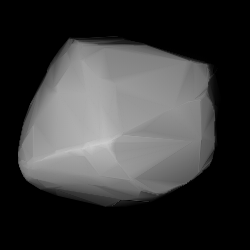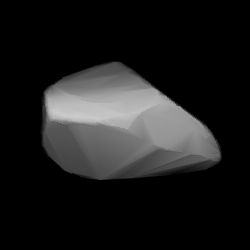Related Research Articles
2069 Hubble, provisional designation 1955 FT, is a carbonaceous asteroid from the outer region of the asteroid belt, approximately 40 kilometers in diameter. It was discovered on 29 March 1955, by the Indiana Asteroid Program at Goethe Link Observatory, United States, and named after American astronomer Edwin Hubble.
2127 Tanya, provisional designation 1971 KB1, is a carbonaceous asteroid from the outer region of the asteroid belt, approximately 40 kilometers in diameter. It was discovered on 29 May 1971, by Russian astronomer Lyudmila Chernykh at the Crimean Astrophysical Observatory in Nauchnij, on the Crimean peninsula. It was named in memory of Tanya Savicheva, a Russian child diarist during World War II.

1054 Forsytia is a dark background asteroid, approximately 46 kilometers in diameter, from the outer regions of the asteroid belt. It was discovered on 20 November 1925, by astronomer Karl Reinmuth at the Heidelberg-Königstuhl State Observatory in southwest Germany and assigned provisional designation 1925 WD. It is named after the flowering plant forsythia, and marks the beginning of a sequence of 28 thematically named asteroids by the discoverer.
1070 Tunica, provisional designation 1926 RB, is a dark background asteroid from the outer regions of the asteroid belt, approximately 35 kilometers in diameter. It was discovered on 1 September 1926, by German astronomer Karl Reinmuth at the Heidelberg-Königstuhl State Observatory in southwest Germany. The asteroid was named after Petrorhagia, a flowering plant also known as "Tunica".
1076 Viola, provisional designation 1926 TE, is a Nysian asteroid from the inner regions of the asteroid belt, approximately 22 kilometers in diameter. It was discovered on 5 October 1926, by German astronomer Karl Reinmuth at the Heidelberg Observatory in southwest Germany. The asteroid was named after the flowering plant Viola.

1080 Orchis, provisional designation 1927 QB, is an dark background asteroid from the inner regions of the asteroid belt. It was discovered on 30 August 1927, by German astronomer Karl Reinmuth at the Heidelberg Observatory in southwest Germany. The carbonaceous F-type asteroid has a rotation period of 16.1 hours and measures approximately 22 kilometers in diameter. It was named after the flowering plant Orchis.

1081 Reseda is a dark background asteroid from the outer regions of the asteroid belt. It was discovered on 31 August 1927, by astronomer Karl Reinmuth at the Heidelberg-Königstuhl State Observatory in southwest Germany. The asteroid has a rotation period of 7.3 hours and measures approximately 37 kilometers in diameter. It was named after the herbaceous plant Reseda.

1082 Pirola is a dark Themistian asteroid from the outer regions of the asteroid belt. It was discovered on 28 October 1927, by German astronomer Karl Reinmuth at the Heidelberg-Königstuhl State Observatory in Germany, and assigned the provisional designation 1927 UC. The carbonaceous C-type asteroid has a rotation period of 15.9 hours and measures approximately 41 kilometers in diameter. It was named after the herbaceous plant Pyrola (wintergreen).
1085 Amaryllis, provisional designation 1927 QH, is a background asteroid from the outer regions of the asteroid belt, approximately 69 kilometers in diameter. It was discovered on 31 August 1927, by astronomer Karl Reinmuth at the Heidelberg-Königstuhl State Observatory in southwest Germany. The asteroid was named after the flowering plant Amaryllis.
1092 Lilium, provisional designation 1924 PN, is a dark, carbonaceous background asteroid from the outer regions of the asteroid belt, approximately 44 kilometers in diameter. It was discovered on 12 January 1924, by German astronomer Karl Reinmuth at the Heidelberg Observatory in southwest Germany. The asteroid was named after the flower Lilium.
1232 Cortusa, provisional designation 1931 TF2, is a background asteroid from the outer regions of the asteroid belt, approximately 40 kilometers (25 miles) in diameter. It was discovered on 10 October 1931, by astronomer Karl Reinmuth at the Heidelberg Observatory in southwest Germany. The X-type asteroid has a rotation period of 25.2 hours. It was named after the plant Cortusa and indirectly honors astronomer Gustav Stracke.
2126 Gerasimovich, provisional designation 1970 QZ, is a stony background asteroid from the inner regions of the asteroid belt, approximately 8 kilometers in diameter. It was discovered on 30 August 1970, by Soviet astronomer Tamara Smirnova at the Crimean Astrophysical Observatory in Nauchnyj, on the Crimean peninsula. The asteroid was named after Russian astronomer Boris Gerasimovich.
2324 Janice, provisional designation 1978 VS4, is a dark background asteroid from the outer regions of the asteroid belt, approximately 25 kilometers (16 miles) in diameter. It was discovered on 7 November 1978, by American astronomers Eleanor Helin and Schelte Bus at the Palomar Observatory in California. The asteroid was named for Janice Cline at Caltech. The presumably C-type asteroid has a rotation period of 23.2 hours.
1233 Kobresia, provisional designation 1931 TG2, is a carbonaceous background asteroid from the central regions of the asteroid belt, approximately 33 kilometers in diameter. It was discovered on 10 October 1931, by German astronomer Karl Reinmuth at the Heidelberg Observatory in southwest Germany. The asteroid was named for the grass-like flowering plant Kobresia, a genus in the sedge family.
1174 Marmara, provisional designation 1930 UC, is a stony Eoan asteroid from the outer regions of the asteroid belt, approximately 17 kilometers in diameter. It was discovered on 17 October 1930, by German astronomer Karl Reinmuth at Heidelberg Observatory in southwest Germany. The asteroid was later named after the Sea of Marmara, located between Europe and Asia.
4804 Pasteur, provisional designation 1989 XC1, is a carbonaceous background asteroid from the central regions of the asteroid belt, approximately 20 kilometers in diameter. It was discovered on 2 December 1989, by Belgian astronomer Eric Elst at the ESO's La Silla Observatory in Chile. The asteroid was named after French chemist and microbiologist Louis Pasteur.
3184 Raab, provisional designation 1949 QC, is a dark background asteroid and a potentially slow rotator from the central regions of the asteroid belt, approximately 17 kilometers in diameter. It was discovered on 22 August 1949, by South African astronomer Ernest Leonard Johnson at the Union Observatory in Johannesburg. The likely C-type asteroid could have a long rotation period of 275 hours. It was named after Austrian amateur astronomer and software engineer Herbert Raab.

1424 Sundmania is a large asteroid and rather slow rotator from the background population of the outer regions of the asteroid belt. It was discovered on 9 January 1937, by astronomer Yrjö Väisälä at the Turku Observatory in southwest Finland. The dark X-type asteroid has a notably long rotation period of 93.7 hours and measures approximately 70 kilometers in diameter. It was named after Finnish astronomer and mathematician Karl F. Sundman.

2120 Tyumenia is a dark background asteroid, approximately 45 kilometers in diameter, located in the outer regions of the asteroid belt. It was discovered on 9 September 1967, by Soviet astronomer Tamara Smirnova at the Crimean Astrophysical Observatory in Nauchnyj, on the Crimean peninsula. The asteroid was named for the now Russian district of Tyumen Oblast in Western Siberia.

1301 Yvonne is a carbonaceous background asteroid from the background population of the intermediate asteroid belt, approximately 21 kilometers in diameter. It was discovered on 7 March 1934, by French astronomer Louis Boyer at the Algiers Observatory in North Africa. The asteroid was named for the discoverer's sister, Yvonne Boyer
References
- 1 2 3 4 "JPL Small-Body Database Browser: 1250 Galanthus (1933 BD)" (2017-11-27 last obs.). Jet Propulsion Laboratory. Retrieved 31 December 2017.
- ↑ "Galanthus". Merriam-Webster.com Dictionary .
- 1 2 3 4 Schmadel, Lutz D. (2003). "(1250) Galanthus". Dictionary of Minor Planet Names – (1250) Galanthus. Springer Berlin Heidelberg. p. 102. doi:10.1007/978-3-540-29925-7_1251. ISBN 978-3-540-00238-3.
- 1 2 "Asteroid 1250 Galanthus – Proper Elements". AstDyS-2, Asteroids – Dynamic Site. Retrieved 29 October 2019.
- 1 2 3 4 Nugent, C. R.; Mainzer, A.; Masiero, J.; Bauer, J.; Cutri, R. M.; Grav, T.; et al. (December 2015). "NEOWISE Reactivation Mission Year One: Preliminary Asteroid Diameters and Albedos". The Astrophysical Journal. 814 (2): 13. arXiv: 1509.02522 . Bibcode:2015ApJ...814..117N. doi:10.1088/0004-637X/814/2/117. S2CID 9341381 . Retrieved 31 December 2017.
- 1 2 3 4 Mainzer, A.; Grav, T.; Masiero, J.; Hand, E.; Bauer, J.; Tholen, D.; et al. (November 2011). "NEOWISE Studies of Spectrophotometrically Classified Asteroids: Preliminary Results". The Astrophysical Journal. 741 (2): 25. arXiv: 1109.6407 . Bibcode:2011ApJ...741...90M. doi:10.1088/0004-637X/741/2/90. S2CID 35447010.
- 1 2 3 4 Usui, Fumihiko; Kuroda, Daisuke; Müller, Thomas G.; Hasegawa, Sunao; Ishiguro, Masateru; Ootsubo, Takafumi; et al. (October 2011). "Asteroid Catalog Using Akari: AKARI/IRC Mid-Infrared Asteroid Survey". Publications of the Astronomical Society of Japan. 63 (5): 1117–1138. Bibcode:2011PASJ...63.1117U. doi:10.1093/pasj/63.5.1117. (online, AcuA catalog p. 153)
- 1 2 3 Masiero, Joseph R.; Grav, T.; Mainzer, A. K.; Nugent, C. R.; Bauer, J. M.; Stevenson, R.; et al. (August 2014). "Main-belt Asteroids with WISE/NEOWISE: Near-infrared Albedos". The Astrophysical Journal. 791 (2): 11. arXiv: 1406.6645 . Bibcode:2014ApJ...791..121M. doi:10.1088/0004-637X/791/2/121. S2CID 119293330.
- 1 2 3 4 Nugent, C. R.; Mainzer, A.; Bauer, J.; Cutri, R. M.; Kramer, E. A.; Grav, T.; et al. (September 2016). "NEOWISE Reactivation Mission Year Two: Asteroid Diameters and Albedos". The Astronomical Journal. 152 (3): 12. arXiv: 1606.08923 . Bibcode:2016AJ....152...63N. doi: 10.3847/0004-6256/152/3/63 .
- 1 2 3 4 Tedesco, E. F.; Noah, P. V.; Noah, M.; Price, S. D. (October 2004). "IRAS Minor Planet Survey V6.0". NASA Planetary Data System. 12: IRAS-A-FPA-3-RDR-IMPS-V6.0. Bibcode:2004PDSS...12.....T . Retrieved 22 October 2019.
- 1 2 3 Waszczak, Adam; Chang, Chan-Kao; Ofek, Eran O.; Laher, Russ; Masci, Frank; Levitan, David; et al. (September 2015). "Asteroid Light Curves from the Palomar Transient Factory Survey: Rotation Periods and Phase Functions from Sparse Photometry". The Astronomical Journal. 150 (3): 35. arXiv: 1504.04041 . Bibcode:2015AJ....150...75W. doi:10.1088/0004-6256/150/3/75. S2CID 8342929 . Retrieved 31 December 2017.
- 1 2 Binzel, R. P.; Mulholland, J. D. (December 1983). "A photoelectric lightcurve survey of small main belt asteroids". Icarus. 56 (3): 519–533. Bibcode:1983Icar...56..519B. doi:10.1016/0019-1035(83)90170-7. ISSN 0019-1035 . Retrieved 31 December 2017.
- 1 2 3 4 "LCDB Data for (1250) Galanthus". Asteroid Lightcurve Database (LCDB). Retrieved 31 December 2017.
- 1 2 "1250 Galanthus (1933 BD)". Minor Planet Center. Retrieved 31 December 2017.
- ↑ Schmadel, Lutz D. (2007). "(1054) Forsytia". Dictionary of Minor Planet Names – (1054) Forsytia. Springer Berlin Heidelberg. p. 90. doi:10.1007/978-3-540-29925-7_1055. ISBN 978-3-540-00238-3.